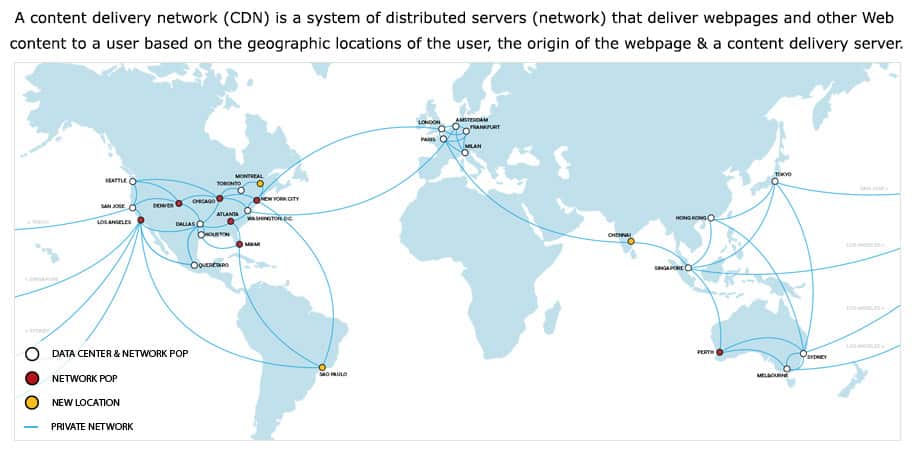What is a Content Delivery Network?
A content delivery network or content distribution network (CDN) is a large distributed system of servers deployed in multiple data centers across the Internet. CDNs are caching servers for static content, such as HTML pages, images, style sheets and JavaScript files, and dynamic content, such as media streams and database queries, to minimize latency. When a user requests content that is available on a CDN, the request is automatically routed to the origin server that can best serve the content. CDNs are used to improve performance and availability by providing high-bandwidth data pipes between the origin server and end user. By replicating content across its points of presence (PoPs), a CDN can increase reliability through redundancy. Additionally, because all requests are served from the nearest PoP, a CDN can also improve performance by minimizing latency.
Why do I need a Content Delivery Network?
There are many reasons why you might want to use a CDN, including the following:
- To improve website performance by reducing latency and increasing bandwidth.
- To increase website reliability by providing redundancy and availability.
- To improve website security by providing DDoS protection and other security features.
- To save money on infrastructure costs by using a shared network.
How does a Content Delivery Network work?
A CDN is a large distributed system of servers deployed in multiple data centers across the Internet. The CDN servers infrastructure is responsible for delivering content to the end user. When a user requests content that is available on a CDN, the request is automatically routed to the nearest CDN server. The CDN servers then retrieve the content from the origin server and delivers it to the end user computer or mobile devices of mobile users.
- Speeding up web content and web pages
- Reducing bandwidth costs
- Improving website availability and reliability
- Enhancing security with SSL, DDoS protection, and other security features.
- Reduce network congestion
- Increased data security
- Reduce bandwidth consumption
- Load balancing
- SEO Boost
- Improved User Experience
- Crash resistance
Content delivery networks have a number of benefits for both website owners and visitors. For website owners, CDNs can speed up the loading time of their pages by storing a cached version of their content in multiple locations around the world. This is especially useful for websites with large amounts of international traffic. CDN servers can also reduce bandwidth costs by serving
Content delivery networks for websites
If you own a website or sell digital downloads, you need a Content Delivery Network (CDN’s). Normally a website, or digital download file, is hosting located in one place. If that is a popular website/file and many people try and access it at once you can become very slow or even crash the server. Content Delivery Networks (CDN’s) are a network of servers that are linked up and sync’d up to allow delivery of content to locations across the globe. Eg someone living in Brisbane would have their files delivered from a server in Australia, someone in London would have their content delivered from a server in the UK. This reduces both server load and increases the speed of delivery.
Our current Content Delivery Network Project
We are currently planning a global ebook sale for a client here in Brisbane. I’m currently watching our test file load and sync up content between servers located in Amsterdam, Chennai, Dallas, Frankfurt, Hong Kong, London, Melbourne, Mexico, Milan, Montreal, Paris, Sao Paulo, San Jose, Singapore, Sydney, Tokyo, Toronto & Washington. It’s such an amazing thing when you are sitting watching it happen and it’s inspired this post.
Our last project was an online video course with content being delivered around the world. It’s extremely important to have all videos streaming clearly so a content delivery network was used.
Is it easy to use a Content Delivery Network?
In short, yes! For most websites and digital file downloads, setup can be done in minutes and you can be getting benefits within hours. If you have a website the best way to use a CDN is to set it up so that your webpages and files are delivered from the CDN automatically. This can be done using a simple plugin. If you’re not sure, just ask us to assist.
You can also host your entire website on a CDN. Many large companies do this as it’s more secure and can handle high traffic loads without issue.
Do you use a Content Delivery Network
We also incorporate content delivery networks in our website and downloads to deliver our images, scripting files, movies and music.
Is it expensive to use a Content Delivery Network?
It’s a competitive market and that means pricing is very good at the moment. Pricing is based on the amount of data delivered but for a standard website it could be as little as $30/month and the benefits in page loading speed is usually amazing. Remembering that the faster a page loads, the less waiting the end user does and the more likely they are to purchase something or call you.
How do I get started with a Content Delivery Network?
Talk to us about how we can easily and quickly setup a content delivery network for your website or digital downloads. We’ll give you some options and once you’re happy we’ll get it all setup for you so you’re getting the benefits as soon as possible.
Click Here To Contact Us
If you’re interested in adding a CDN to your website or download, or would like any more information, please feel free to contact us.



